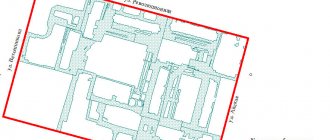What is a land easement?
Civil Code of the Russian Federation in Art. 274 gives the concept of easement. This is the provision of the opportunity for limited use of a plot of land located in the neighborhood, in cases where this is necessary. An easement can be established, for example, to provide access/passage through the territory of the site.
It is important to know that the establishment of this encumbrance is considered a last resort measure, used only in cases where there are no other ways to meet the needs of the land owner.
An easement is established between two parties under an agreement: the owner of the site and requiring the establishment of an encumbrance with subsequent registration in Rosreestr. If it is not possible to reach an agreement, the dispute is resolved in court.
How to establish an easement on a land plot and what is necessary for this?
If you are interested in the question of how to establish an easement on PART of a land plot, we talk about this at the end of the article. Public easements were also discussed earlier in this material.
If there is a need to use a neighboring or other site, i.e. To establish an easement, the interested party must contact its owner (ZU) and act on the basis of our instructions. Having considered the possibilities of its joint use, the parties come to an agreement, which is set out in writing and is defined as an agreement of the parties to establish an easement.
An agreement on easement of a land plot (you can find a sample at the end of the article) is a type of agreement between the parties. Meets the general requirements for drafting and concluding contracts. On its basis, a civil action is carried out, the circumstances of which are determined within the framework of the agreement.
This agreement is often called a land easement agreement .
Here it is required to identify the parties involved in concluding an agreement on the mutual use of a land plot and provide the cadastral and technical characteristics of the land plot. The main part of the agreement should describe in detail, but concisely and legally correct :
- what area of the site is limited;
- its location on the site;
- what work is planned to be carried out;
- what objects to locate;
- term of use;
- conditions for return and early termination.
The parties indicate the legal issues that are significant to them in order to avoid the development of a conflict, as well as to comply with all obligations in the agreement on the establishment of an easement. It is necessary to provide for everything necessary, so that later all that remains is to follow the agreements reached, without going beyond their scope. If we are talking about large volumes of work, it is advisable to draw up a planning project for the restricted area.
An easement is subject to state registration as a type of transaction between persons, therefore the finished text is signed by the parties and requires registration with Rosreestr.
If the land plot is not owned, but is leased from the administration or has the right of permanent (perpetual) use (the obtaining algorithm is described here) - the agreement is attached to the applications of the parties , which are submitted to the administration at the location of the land plot. You are also required to present a certificate of ownership of the plot. The administration considers them for no more than 30 days and makes a decision. A positive decision becomes the basis for further action. The refusal can be challenged in court, and in case of technical errors, you can correct them and resubmit applications.
State registration of easements is carried out after receiving an extract from the decision of the administrative commission. For the owner, it is enough to draw up an agreement. The parties go to the registrar window at the local cadastre and cartography office or at the multifunctional center and submit documents confirming:
- identity of the parties;
- ownership of the site by a party to the agreement;
- permission from the administration to establish an easement.
Documents are accepted against a receipt indicating the date of issue of the easement registration. Usually it is 21 working days.
All actions carried out in the administration do not require payment. If the parties find it difficult to draw up an agreement on their own, they need to contact a lawyer. Drawing up an agreement costs from 5 to 10 thousand rubles , depending on the region of residence and the qualifications of the specialist.
It is mandatory to pay a state fee when submitting an agreement for registration. It is established on the basis of Article 333.33 of the Tax Code of the Russian Federation. Since the beginning of 2015, the cost of registering an easement is:
- 2 thousand rubles – to individuals;
- 22 thousand – legal.
This simple procedure for establishing an easement on a land plot is in effect here in the Russian Federation.
Types of land use restrictions
Legally, encumbrances on land plots are distinguished:
- Private easement. It is applied on the basis of a concluded and registered agreement or court decision when the interests of a certain person or organization are affected. Typically, such an encumbrance is of a compensated nature and the owner of the land has the right to demand a reasonable payment from citizens or legal entities in whose favor the encumbrance is registered. Except in cases where federal legislation is applied, obliging the application of a gratuitous restriction or when the owner himself voluntarily refused the payment.
- Public easement. Established subject to the availability of a regulatory document of a government body or municipal entity. It can be imposed on the territory of land through which public communications are carried out, for example, water supply, gas pipelines. Here, the land owner cannot count on monetary compensation in connection with the imposition of an encumbrance.
Easements also differ according to the period for which they are established, it happens:
- permanent, without setting a deadline;
- urgent, when a specific period during which it will be valid is determined, or the occurrence of an event upon the occurrence of which the servitude will be lifted. As a rule, it is imposed in the case of certain work related to the laying of communications. Then, as soon as the work is completed, the encumbrance ceases;
Types of land easements
There are several classifications of easements for plots of land.
Depending on the possible time of land use by someone else’s plot of land, the encumbrance can be:
- urgent;
- permanent.
The main difference between a temporary easement is the exact duration of its validity. The need for an urgent easement, as a rule, arises when it is necessary to perform some specific work or lay communications. Upon completion of these works, the encumbrance ceases.
In practice, there is such a type as permanent-temporary. The idea is that actual use arises only at certain points during the perpetuity.
For example, every spring the road leading to the plot is flooded by a river flood, and for 2 months of the year the owner can only get to his plot through the neighboring land. The easement can be established for an indefinite period, but each year the neighbor's plot can be used from May to June.
Based on the legal basis for imposing an encumbrance, easements are divided into:
- private;
- public.
A public easement is registered in Rosreestr on the basis of a legislative or other regulatory document adopted at the level of the federation, its constituent entities or an individual municipality. In particular, a public easement may be imposed when providing gas, water, and other communications for public use.
Private, affecting the interests of a particular citizen or organization, is established on the basis of an easement agreement for a land plot or a court decision in favor of this citizen/organization.
Differences between easements
- The imposition of a public easement is dictated by the need to introduce limited use of land in the interests of the state, or a municipality, or a large circle of persons, and a private one - to ensure the rights of one or more citizens (organizations).
- Mostly, a private easement is of a paid nature, while a public easement is gratuitous. In the first case, the absence of payment as an exception may be when it is provided for by law. In other situations, the owner of land encumbered by a private easement has the right to demand and receive monetary compensation from citizens and companies claiming the encumbrance. The absence of payment is also possible if the land owner voluntarily refuses it.
- Various reasons for its occurrence. Thus, restrictions established by public entities are based on regulatory documents, and a private easement is based on the demand of a citizen, companies or group of citizens.
Grounds for the creation of an easement
The reasons and cases of application of easements to land plots are listed in Article 23 of the Land Code.
An encumbrance in the form of a public easement is used:
- to provide passage/passage through a piece of land if another route cannot be provided, for example, to the shoreline and a public reservoir;
- when part of the site is used for driving farm animals, making hay, or grazing animals at a certain time;
- for drainage work;
- when operating the allotment as a hunting and fishing zone;
- for repair of communications and use of this site;
- when the site is used for the purposes of research and survey work for a certain period.
An easement on a part of the land is required in order to provide other persons with the right to exploit someone else’s land when no other way exists. That is, this type of encumbrance can only be registered by a person whose rights cannot be realized without using someone else’s allotment. An easement is imposed by mutual agreement or forced by a court decision.
A private encumbrance can only be established to fulfill personal needs. For example, a citizen owns a plot of land where there is a natural water source. The owners of neighboring territories have the right to ask or demand permission to pass through the territory of private land to a source to collect water.
Types of easements
According to the distribution of action there are 2 types:
- public;
- private.
| Factors | Public easement | Private easement |
| What is encumbered | land | Any type of real estate |
| Beneficiaries | unlimited circle of people | individual |
| Deadlines | ● urgent (temporary); ● unlimited (permanent) | |
| Reasons | legislative act | ● court decision; ● agreement |
| Land owner rights | ● receiving payment from the authorities who established the easement; ● purchase of a plot | ● collection of fees from the beneficiary (in any case); ● removal of the encumbrance if the need has disappeared; ● remove the easement in court if it is impossible to use the land for its intended purpose |
| Reasons | public and government needs (all levels) | individual interest |
| Establishment method | ● normative act; ● legislative act. Preliminary hearing required | ● court decision; ● contract |
In terms of time:
- urgent;
- unlimited
An encumbrance that is not limited by any period will remain in effect continuously until real conditions change and the grounds in connection with which the encumbrance arose disappear. This form is often used when imposing a public easement, for example, when laying roads, electrical networks and gas pipes. But even on these grounds, the issue is subject to discussion at the hearing.
Establishment of land easement
The law regulates the application of land encumbrance; it can be established on the basis of:
- written agreements between two or more persons, the owner of a land plot on the one hand, interested in its use and initiating the imposition of an easement, on the other;
- a decision made by a state body or municipal entity through public hearings;
- judge's decisions.
A private easement can be established with the voluntary consent of both parties. A person interested in the limited use of someone else's land and wishing to have legal grounds for doing so approaches the owner of the land with such a proposal.
If you manage to reach an agreement, it is imperative to formalize all oral agreements in writing in an agreement, where you indicate:
- the purposes for which the area encumbered by the easement will be used;
- list all the rights and obligations of the parties to the agreement;
- establish a certain fee for the use of the territory of the land plot.
Then the easement right must be registered with the Rosreestr body. Only upon completion of the entire procedure does the agreement become legal and is valid from the date of registration of the encumbrance. From this moment on, the plot of land specified in the agreement can be used by an interested person, and the owner of the plot will be able to demand the appropriate payment for this.
If it is impossible to reach an agreement in the usual way, the initiator of the imposition of the easement can go to court, which will help resolve the controversial issue. This type of solution is also required to document the right to use part of the land when its owner allows this, but refuses to formalize it. Often, in the event of any conflict, the owner can stop the use and limit access to the territory to which he has legal rights. To prevent this from happening, it is better for the interested party to receive guarantees that he will be able to continue to exploit part of someone else’s land.
The court's decision can only be influenced by evidence that the plaintiff has no other option than imposing an easement on someone else's land. Therefore, the interested party must prove to the judge:
- His personal rights without imposing an encumbrance on a plot of neighboring land will be infringed. For example, it is impossible to lay a water pipe to your home without touching someone else’s property.
- The parties failed to come to an agreement peacefully and conclude an agreement. Perhaps the land owner is demanding an inflated payment or putting forward other conditions that the plaintiff does not agree to.
When considering the submitted materials, the court will be guided by the principle of the rights of each party and a reasonable balance of their interests. Restrictive measures applied to land should cause the least inconvenience to the land owner. The rights of the plaintiff should also not be infringed and only his necessary needs should be realized.
For example: The plaintiff is seeking the opportunity to conduct communications to his house through the territory of a neighbor’s land plot or to carry out passage/drive through it. The judge reviews the case materials and decides which part of the site can be used for this purpose, establishes the route of passage or passage, and also establishes the terms of the encumbrance, the tariff and the terms of payment that will be required in the form of compensation for the easement.
Validity
An easement can be urgent or indefinite. Certain conditions for the release of the encumbrance must be set out in the contract. An easement may be withdrawn for the following reasons:
- the arrival of the agreed date specified in the agreement of the parties;
- the occurrence of an event that removes the effect of the encumbrance.
It should be taken into account that the encumbrance concerns a plot of land and does not disappear anywhere when the owner changes. According to Article 278 of the Civil Code, it passes to the new owner.
Sample
Forms of agreements to establish an easement on a plot of land:
- urgent, paid -
- indefinite, gratuitous -
- permanent, paid -
Why is a land easement needed?
The need for an easement arises among the owners of neighboring territories, but not for the sake of expanding their areas, but for the opportunity to use their plots with the help of their neighbor’s lands.
The establishment of easements on land plots may be required for various reasons.
- Example 1: on a piece of land owned by a private individual, there is a natural source of water that cannot belong to him by right of ownership, and the owners of neighboring lands may ask or demand the right of passage to this source and abstraction of water from it.
- Example 2: construction work is underway on a designated plot of land, but the water supply to the house under construction can only be routed through the neighboring plot, the legal owner of which is a citizen. To install the required communication systems, an encumbrance in the form of an easement is placed on this plot of land, and the construction company can legally use a specific part of the plot for specified purposes.
Easements in relation to a land plot are the last option for solving a land problem when all other possibilities have been exhausted. For some unimportant purposes, an easement cannot be demanded, for example, there is a road to the site, but it is not so short, in this regard, gaining access to someone else’s site in order to drive straight, shortening a couple of hundred meters, is not permissible.
At its core, an easement is the same lease, only its conclusion is a forced measure for both parties and the owner of the land, along with the recipient of the easement, can continue to use the encumbered part of the site.
Land easements may be imposed:
- and by agreement of persons wishing to use the land with the owner of the land;
- and in a forced judicial manner, without obtaining his consent.
However, only a person who has no other opportunity to exercise his rights without obtaining permission to limitedly exploit someone else’s land has the right to apply for registration of an easement.
Payment for easement on land
The owner of the land has the right to legally demand payment for the use of his territory from an interested person. The amount of the payment itself must be adequate and commensurate. Both parties can independently agree on how expensive it will be for the initiator of the easement to use part of the neighbor’s land and specify the tariff in the agreement. If it is impossible to come to a mutual decision, only going to court will help.
The owner of the land has the right not to establish a fee and to enter into an agreement on the free establishment of an easement.
Grounds for termination of public land easement
In order to terminate an easement established for public purposes, you need to understand the reasons for its cancellation.
Thus, a public easement can be canceled for the following reasons:
- The reasons why a public easement was established have disappeared
- The easement has expired
- Violation of the rules for establishing a public easement
- Inability to use the easement in accordance with the permitted type of use of the land plot on which such an easement is established
- Violation of the law by the user of the easement, within the framework of the activity for which such an easement was established
Grounds for termination of a public land easement established for special purposes
However, a public easement established for special purposes can be terminated before the period established by the agreement on the establishment of the easement. And the reasons are as follows:
- The land on which the easement is established has not been used for more than two years
- There is no payment for the use of easements
- In the event that the user himself refuses the easement
It is worth understanding that this list is not exhaustive. However, the presence of reasons not provided for by current legislation will have to be proven in court.
It is important to note that a lot of documentary evidence can only be obtained through legal or judicial requests, since the defendant is unlikely to agree to provide it to you voluntarily.
Under what conditions is it possible to establish an easement on a land plot?
The establishment of an easement on a land plot can only be carried out if no other options can be used.
In the event that the person initiating the establishment of an easement specifically tries to impose an encumbrance on someone else’s land, pursuing only the goals of personal gain, he will have to answer before the law for fraudulent actions in relation to someone else’s property.
The current legislation contains an exhaustive list of grounds on which an easement can be established on a land plot.
This list cannot be edited in any way except at the initiative of the state represented by its legislative bodies.
This is due to the fact that when an easement is established, the owner of the encumbered land plot will not be able to fully use his property.
These goals will include:
- Use of the territory of a neighboring plot or part thereof to ensure unimpeded access for owners of plots located in a worse territorial situation than the encumbered plot;
- The impossibility of carrying out the necessary engineering communications in any other way than through the territory of the encumbered plot, which will be used for the full functioning of other land plots;
- Use of the territory of the encumbered plot or part of such territory for the passage of people and animals to water bodies, with the help of which the full functioning of neighboring plots or existing livestock farms is carried out;
- In the case of a public easement, the purposes of use also include the installation of communication means or tower stations that can provide a sufficient level of communication quality;
- Another area for which a public easement can be established is the construction of transport hubs and interchanges. In the event that such an easement has been established, and the owner of the encumbered plot cannot use it in full, such plot is subject to redemption at the expense of the state.
A public easement can also be established for the construction in the area adjacent to the encumbered area of objects whose purpose is to protect the security of the state.
In this case, if the degree of encumbrance is maximum, the plot is subject to purchase by the state.
There are no other conditions for which a public or private easement may be established in the current legislation. If the person who initiated the establishment of the easement tries to implement such an encumbrance for any other reasons, his actions can be appealed in court.








